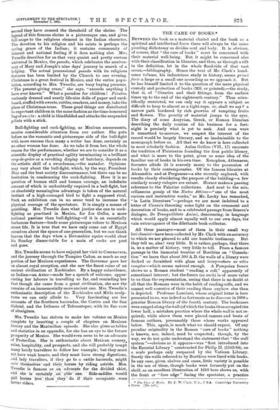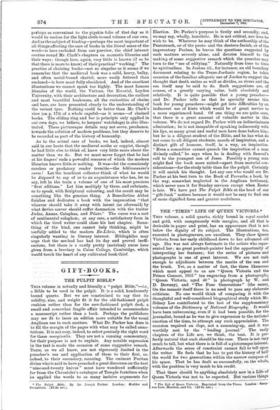THE CARE OF BOO$S.*
BETWEEN the book as a material chattel and the book as a spiritual and intellectual force there will always be the same puzzling dichotomy as divides soul and body. It is obvious, of course, that " the care of books" must be concerned with their material well-being. But it might be concerned also with their classifiCation in libraries, and thus, as through a rift in the definition, let in the whole flood-tide of that• vast ocean,—bibliography. Hence the text of Mr. Clark's hand- some volume, his industrious study in history, seems prima fade a large or a small one according as we appoach it. But he has himself limited it to the question of the mere physical custody and protection of books (MS. or printed),—the study, that is, of "libraries and their fittings, from the earliest times up to the end of the eighteenth century." Thus scien- tifically restricted, we can only say it appears a subject as difficult to keep to almost as a tight-rope, or, shall we say ? a narrow path bordered by rich growths of tempting fruits and flowers. The paucity of material jumps to the eyes. The diary of some Assyrian, Greek, or Roman librarian describing the daily routine of his business for a fort- night is precisely what is yet to seek. And even were it unearthed to-morrow, we suspect the interest of the record would be largely literary, and so inadmissible to the monograph before us. All that we do know is' here collected in most scholarly fashion. Aulus Genius (VII., 17) recounts the tradition of Pisistratus founding the first public library, and what is more to the point, gives us some idea of the familiar use of.books in his own time. Xenophon, Athenaeus, Socrates allude (it is scarcely more) to the possession of books by their contemporaries. Of the famous libraries at Alexandria and at Pergamus—a site recently explored, with results clearly elucidating the purpose of the building—a few similarly scanty eulogies are extant. Horace makes a passing reference to the Palatine collections. And next to the mis.: cellaneous gossip of the Noctes Atticae--" one of the most curious and instructive works," as Mr. Leek), has remarked; "in Latin literature "—perhaps we are most indebted to a letter of Cicero's throwing some light on the ornament and decoration of books, and to a celebrated passage from Seneca's dialogue, De Tranquillitate Animi, denouncing; in language which would apply almost equally well to our own days, the vain extravagance of the dilettante book-collector.
All these passages—most of them in their small way loci classici—have been collected by Mr. Clark with an accuracy to which we are pleased to add our humble testimony. But they tell us, alas! very little. It is rather, perhaps, that there, is, as a matter of history, very little to tell. From a famous. passage in the immortal treatise of Boethins on " Conaola-. tion we learn that about 500 A.D. the walls of a library were decked or furnished with glass and --ivory--;-ebore ac triti comptos—which seems natural enough. A Pompeian fresco shows us a Roman student "reading a roll," apparently of sensational interest; but the fresco (as such) is of more value to us than the representation,' seeing that there is no doubt at all that the Romans were in the habit of reading rolls, and we cannot well conceive of their reading them anyhow else than is depicted. Professor Lanciani, whose original letter is here presented to us, was indeed so fortunate as to discover in 1898 a genuine Roman library of the fourth century. The bookcases were ranged along the wall (of which the books thus occupied the lower half, a mistaken practice where the whole wall is not re- quired), while above them were placed cameos and busts of famous authors, presumably those whose works appeared below. This, again, is much what we should expect. Of any peculiar originality in the Roman "care of books" nothing is known, nor, indeed, need be suspected; though, by the way, we do not quite understand the statement that "the wan system "—obvious as it appears—was." first introduced into the Escorial Library" constructed for Philip II. (1563-84), on a scale perhaps only surpassed by the Vatican Library. Surely the walls referred to by Boethius were lined with books. In any case, given shelves and cases,:little variety is possible' in the use of them, though books- were-formerly, put on the • shelf, as an excellent illustration of 1610 here shows us, with; the front or "fore edge" facing the spectator, a practice • The Cave of Books. By J. W. Cla.-k, M.A., F.S.A. Cambridge University Tress. 119s. net.] perhaps as convenient to the pigskin folio of that day as it would be useless for the light cloth-bound volume of our own. And as the subject of binding—perhaps the most important of all things affecting the care of books in the literal sense of the word—is here excluded from our purview, the chief interest centres round Mr. Clark's chapters on monastic libraries and their ways : though here, again, very little is known (if so be that there is more to know) of their practical" working." The practice of chaining books—not so singular as it seems if we remember that the mediteval book was a solid, heavy, bulky, and often metal-bound chattel, more easily fettered than enclosed—is here most fully elucidated. And of the excellent illustrations we cannot speak too highly. The most famous libraries of the world, the Vatican, the Escorial, Leyden University, with their architecture and decoration, the earliest and most beautiful bookcases, all the curiosities of chains and bars, are here presented clearly to the understanding of the veriest tyro. Nothing could be better than Mr. Clark's view (on p. 174) of a whole cageful—as it seems—of chained books. The sliding ring and bar (a principle only applied in our own days, we believe, to keepers' watchdogs) is also illus- trated. These picturesque details may not serve, perchance, towards the solution of modern problems, but they deserve to be recorded as part of the history of humanity.
As to the actual care of books, we had, indeed, almost said in our haste that the medireval scribe or copyist, though he bad little else to think of knew very little more about the matter than we do. But we must never forget that he had at his fingers' ends a powexful resource of which the modern librarian knows little or nothing. It was—let the consciously careless or predatory reader tremble—the bibliomaniac's curse ! Let the touchiest collector think of what he would be disposed to say of -or to an acquaintance who has, let us say, left in the train a volume of one of his most precious "first editions." Let him multiply by three, and rubricate, so to speak, With Scriptural colouring, and the result may be something like the genuine thing. A -Benedictine Abbot finishes and dedicates a book with the imprecation "that whoever, should- take it away with intent (as aforesaid) by what device soever should suffer damnation with the traitor Judas, lianas, Caiaphas, and Pilate." The curse was a sort of sentimental colophon; at any rate, a satisfactory form in which the tired writer could close his last chapter. Some- thing of the kind, one cannot help thinking, might be usefully added to the modern Ex-Idbris, which is often singularly wanting in literary interest. Bibliophiles may urge that the method has had its day and proved ineffi- cacious, but there is a vastly pretty (metrical) cm-se here given from a breviary in Caius College, Cambridge, which would touch the heart of any cultivated book-thief.































































 Previous page
Previous page